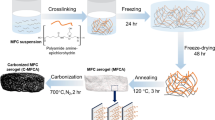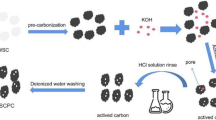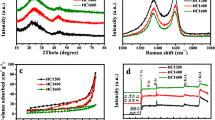Abstract
Biomass-derived carbon (BMC) materials have attracted much attention due to their high performance and properties of abundant source. Herein, biomass carbon sheets (BMCS) from wheat straws had been successfully synthesized via a facile high temperature carbonization and expansion processes. The morphology of BMCS keeps the natural honeycomb-like shape of the cross section and the hollow tubular array structure of the vertical section with rich pores, which provides low-resistant ion channels to support fast diffusion. The (002) crystal plane reveals that the intercalation distance of carbon sheets is 0.383 nm larger than that graphite (0.335 nm), which benefits the larger sodium ion de/intercalation. By comparing different carbonization temperatures, wheat straws carbonized at 1200 °C (BMCS-1200) with well graphite microcrystallites show more excellent sodium ion storage performance than that of 900 °C (BMC-900). BMCS-1200 shows a stable reversible capacity of 221 mAh g−1 after 200 cycles at 0.05 A g−1, while BMC-900 is 162 mAh g−1 after 100 cycles. And it also exhibits better rate capability (220, 109 mAh g−1) than that of BMC-900 (125, 77 mAh g−1) at 0.2 and 1 A g−1, respectively. Finally, it delivers 89 mAh g−1 stable capacity after 1400 cycles at 1 A g−1 to prove its excellent long-term cycling stability.

High temperature carbon sheets with well graphite microcrystallites synthesized from wheat straw forexcellent sodium ion storage performance





Similar content being viewed by others
References
Vikström H, Davidsson S, Höök M (2013) Lithium availability and future production outlooks. Appl Energy 110:252–266
Kim SW, Seo DH, Ma X, Ceder G, Kang K (2012) Electrode materials for rechargeable sodium-ion batteries: potential alternatives to current lithium-ion batteries. Adv Energy Mater 2:710–721
Palomares V, Serras P, Villaluenga I, Hueso KB, Carretero-González J, Rojo T (2012) Na-ion batteries, recent advances and present challenges to become low cost energy storage systems. Energy Environ Sci 5:5884–5901
Slater MD, Kim D, Lee E, Johnson CS (2013) Sodium-ion batteries. Adv Fun Mater 23:947–958
Xie X, Kretschmer K, Zhang J, Sun B, Su D, Wang G (2015) Sn@CNT nanopillars grown perpendicularly on carbon paper: a novel free-standing anode for sodium ion batteries. Nano Energy 13:208–217
Dai KH, Zhao H, Wang ZH, Song XY, Vince B, Liu G (2014) Toward high specific capacity and high cycling stability of pure tin nanoparticles with conductive polymer binder for sodium ion batteries. J Power Sources 263:276–279
Srirama H, Kuppan S, Vishwanathan R, Palani B (2013) A rationally designed dual role anode material for lithium-ion and sodium-ion batteries: case study of eco-friendly Fe3O4. PCCP 15:2945–2953
David L, Bhandavat R, Singh G (2014) MoS2/graphene composite paper for sodium-ion battery electrodes. ACS Nano 8:1759–1770
Wang H, Yu W, Shi J, Mao N, Chen S, Liu W (2016) Biomass derived hierarchical porous carbons as high-performance anodes for sodium-ion batteries. Electrochim Acta 188:103–110
Luo XF, Yang CH, Peng YY, NW P, Ger MD, Hsieh CT, Chang JK (2015) Graphene nanosheets, carbon nanotubes, graphite, and activated carbon as anode materials for sodium-ion batteries. J Mater Chem A 3:10320–10326
Zhu JD, Chen C, Lu Y, Ge YQ, Jiang H, Fu K, Zhang XW (2015) Nitrogen-doped carbon nanofibers derived from polyacrylonitrile for use as anode material in sodium-ion batteries. Carbon 94:189–195
Chen P, Wang LK, Wang G, Gao MR, Ge J, Yuan WJ, Shen Y, Xie A, SH Y (2014) Nitrogen-doped nanoporous carbon nanosheets derived from plant biomass: an efficient catalyst for oxygen reduction reaction. Energy Environ Sci 7:4095–4103
GY X, Han JP, Ding B, Nie P, Pan J, Dou H, Li HS, Zhang XG (2015) Biomass-derived porous carbon materials with sulfur and nitrogen dual-doping for energy storage. Green Chem 17:1668–1674
Jun L, Peter K, Aken PA, Van JM, Yan Y (2015) Energy storage materials from nature through nanotechnology: a sustainable route from reed plants to a silicon anode for lithium-ion batteries. Angew Chem 54:9632–9636
Lotfabad EM, Ding J, Cui K, Kohandehghan A, Kalisvaart WP, Hazelton M, Mitlin D (2014) High-density sodium and lithium ion battery anodes from banana peels. ACS Nano 8:7115–7129
Kim S, Dale BE (2004) Global potential bioethanol production from wasted crops and crop residues. Biomass Bioenergy 26:361–375
Wang HG, Wu Z, Meng FL, Ma DL, Huang XL, Wang LM, Zhang XB (2013) Nitrogen-doped porous carbon nanosheets as low-cost, high-performance anode material for sodium-ion batteries. ChemSusChem 6:56–60
Yang T, Qian T, Wang MF, Liu J, Zhou JQ, Sun ZZ, Chen MZ, Yan CL (2015) A new approach towards the synthesis of nitrogen-doped graphene/MnO2 hybrids for ultralong cycle-life lithium ion batteries. J Mater Chem A 3:6291–6296
Li W, Yang K, Peng J, Zhang L, Guo S, Xia H (2008) Effects of carbonization temperatures on characteristics of porosity in coconut shell chars and activated carbons derived from carbonized coconut shell chars. Ind Crop Prod 28:190–198
Sing KSW (1985) Reporting physisorption data for gas/solid systems with special reference to the determination of surface area and porosity. Pure Appl Chem 57:603–619
Kruk M, Jaroniec M (2001) Gas adsorption characterization of ordered organic-inorganic nanocomposite materials. Chem Mater 13:3169–3183
Fey TK, Lee DC, Lin YY, Kumar TP (2003) High-capacity disordered carbons derived from peanut shells as lithium-intercalating anode materials. Synth Met 139:71–80
Smith AJ, MacDonald MJ, Ellis LD, Obrovac MN, Dahn JR (2012) A small angle X-ray scattering and electrochemical study of the decomposition of wood during pyrolysis. Carbon 50:3717–3723
Marta S, Fuertes AB (2014) Direct synthesis of highly porous interconnected carbon nanosheets and their application as high-performance supercapacitors. ACS Nano 8:5069–5078
Shao YY, Zhang S, Engelhard MH, Li GS, Shao GC, Wang Y, Liu J, Aksay IA, Lin YH (2010) Nitrogen-doped graphene and its electrochemical applications. J Mater Chem 20:7491–7496
Paredes JI, Villar-Rodil S, Solís-Fernández P, Martínez-Alonso A, Tascón JMD (2009) Atomic force and scanning tunneling microscopy imaging of graphene nanosheets derived from graphite oxide. Langmuir ACS J Surf Colloids 25:5957–5968
CY S, YP X, Zhang WJ, Zhao JW, Tang XH, Tsai CH, Li LJ (2009) Electrical and spectroscopic characterizations of ultra-large reduced graphene oxide monolayers. Chem Mater 21:5674–5680
Bommier C, Luo W, Gao W-Y, Greaney A, Ma S, Ji X (2014) Predicting capacity of hard carbon anodes in sodium-ion batteries using porosity measurements. Carbon 76:165–174
Cao YL, Xiao LF, Sushko ML, Wang W, Schwenzer B, Xiao J, Nie ZM, Saraf LV, Yang ZG, Liu J (2012) Sodium ion insertion in hollow carbon nanowires for battery applications. Nano Lett 12:3783–3787
Kaskhedikar NA, Maier J (2009) Lithium storage in carbon nanostructures. Adv Mater 21:2664–2680
Wang LP, Yu L, Wang X, Srinivasan M, ZJ X (2015) Recent developments of electrode materials for sodium ion batteries. J Mater Chem A 3:9353–9378
Prabakar SJR, Jeong J, Pyo M (2015) Nanoporous hard carbon anodes for improved electrochemical performance in sodium ion batteries. Electrochim Acta 161:23–31
Li DD, Zhang L, Chen HB, Ding LX, Wang SQ, Wang HH (2015) Nitrogen-doped bamboo-like carbon nanotubes: promising anode materials for sodium-ion batteries. Chem Commun 51:16045–16048
Luo XF, Yang CH, Peng YY, Pu NW, Ger MD, Hsieh CT, Chang JK (2015) Graphene nanosheets, carbon nanotubes, graphite, and activated carbon as anode materials for sodium-ion batteries. J Mate Chem A 3:10320–10326
Saravanan KR, Mullaivananathan V, Kalaiselvi N (2015) Dual hetero atom containing bio-carbon: multifunctional electrode material for high performance sodium-ion batteries and oxygen reduction reaction. Electrochim Acta 176:670–678
LM W, Buchholz D, Vaalma C, Giffin GA, Passerini S (2016) Apple-biowaste-derived hard carbon as a powerful anode material for Na-ion batteries. Chemelectrochem 3:292–298
Fonseca WS, Meng XH, Deng D (2015) Trash to treasure: transforming waste polystyrene cups into negative electrode materials for sodium ion batteries. ACS Sustain Chem Eng 3:2153–2159
Acknowledgements
The present work was financially supported by the Yancheng City Cooperative Innovation Fund Project (No. YKA201219), the Natural Science Foundation of Jiangsu Province, China (No. BK20141261), and the joint research project among industry and university as well as institute of Jiangsu Province, China (No. BY2015057-35).
Author information
Authors and Affiliations
Corresponding author
Electronic supplementary material
ESM 1
(DOC 482 kb)
Rights and permissions
About this article
Cite this article
Qin, D., Chen, S. A sustainable synthesis of biomass carbon sheets as excellent performance sodium ion batteries anode. J Solid State Electrochem 21, 1305–1312 (2017). https://doi.org/10.1007/s10008-016-3485-z
Received:
Revised:
Accepted:
Published:
Issue Date:
DOI: https://doi.org/10.1007/s10008-016-3485-z




